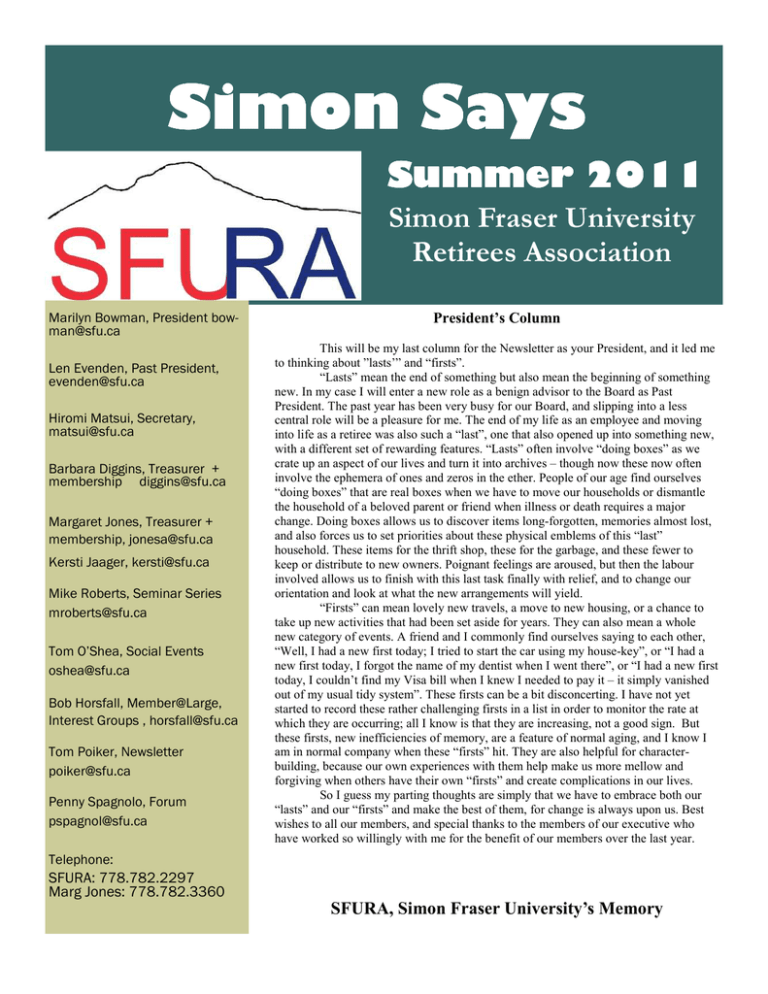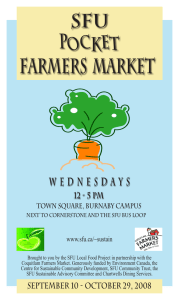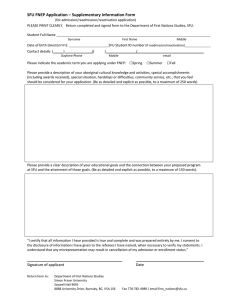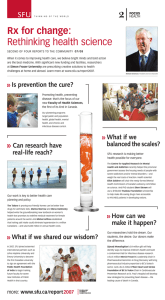Summer 2011 Simon Fraser University Retirees Association
advertisement

Simon Says Summer 2011 Simon Fraser University Retirees Association Marilyn Bowman, President bowman@sfu.ca Len Evenden, Past President, evenden@sfu.ca Hiromi Matsui, Secretary, matsui@sfu.ca Barbara Diggins, Treasurer + membership diggins@sfu.ca Margaret Jones, Treasurer + membership, jonesa@sfu.ca Kersti Jaager, kersti@sfu.ca Mike Roberts, Seminar Series mroberts@sfu.ca Tom O’Shea, Social Events oshea@sfu.ca Bob Horsfall, Member@Large, Interest Groups , horsfall@sfu.ca Tom Poiker, Newsletter poiker@sfu.ca Penny Spagnolo, Forum pspagnol@sfu.ca President’s Column This will be my last column for the Newsletter as your President, and it led me to thinking about ”lasts’” and “firsts”. “Lasts” mean the end of something but also mean the beginning of something new. In my case I will enter a new role as a benign advisor to the Board as Past President. The past year has been very busy for our Board, and slipping into a less central role will be a pleasure for me. The end of my life as an employee and moving into life as a retiree was also such a “last”, one that also opened up into something new, with a different set of rewarding features. “Lasts” often involve “doing boxes” as we crate up an aspect of our lives and turn it into archives – though now these now often involve the ephemera of ones and zeros in the ether. People of our age find ourselves “doing boxes” that are real boxes when we have to move our households or dismantle the household of a beloved parent or friend when illness or death requires a major change. Doing boxes allows us to discover items long-forgotten, memories almost lost, and also forces us to set priorities about these physical emblems of this “last” household. These items for the thrift shop, these for the garbage, and these fewer to keep or distribute to new owners. Poignant feelings are aroused, but then the labour involved allows us to finish with this last task finally with relief, and to change our orientation and look at what the new arrangements will yield. “Firsts” can mean lovely new travels, a move to new housing, or a chance to take up new activities that had been set aside for years. They can also mean a whole new category of events. A friend and I commonly find ourselves saying to each other, “Well, I had a new first today; I tried to start the car using my house-key”, or “I had a new first today, I forgot the name of my dentist when I went there”, or “I had a new first today, I couldn’t find my Visa bill when I knew I needed to pay it – it simply vanished out of my usual tidy system”. These firsts can be a bit disconcerting. I have not yet started to record these rather challenging firsts in a list in order to monitor the rate at which they are occurring; all I know is that they are increasing, not a good sign. But these firsts, new inefficiencies of memory, are a feature of normal aging, and I know I am in normal company when these “firsts” hit. They are also helpful for characterbuilding, because our own experiences with them help make us more mellow and forgiving when others have their own “firsts” and create complications in our lives. So I guess my parting thoughts are simply that we have to embrace both our “lasts” and our “firsts” and make the best of them, for change is always upon us. Best wishes to all our members, and special thanks to the members of our executive who have worked so willingly with me for the benefit of our members over the last year. Telephone: SFURA: 778.782.2297 Marg Jones: 778.782.3360 SFURA, Simon Fraser University’s Memory SofTel – SFU Barbara Diggins and Marilyn Bowman SFURA has learned of a new kind of SFU telephone service for home computers that may be of benefit to our members. It is a software program called SofTel. The SFU Retirees Association has recently purchased this and now has a SofTel telephone number: 778.782.2297. SFU is making this Softel software available to faculty, students, staff and retirees. The software allows us to use our home computer as a telephone to make calls to any local telephone numbers without charge after we purchase the software. It is different from Skype in that Skype charges for calls to a regular landline phone, but SofTel does not. You can ‘call’ out from your computer and can receive calls on your computer on the SofTel number. The useful features of this computer-telephone program include, as examples: 1. If no one is available to answer an incoming call on your Softel number on your computer, voice mail will activate and the incoming caller can leave a voice message. The voice mail system is just like regular campus voicemail. In addition, once a voice message is left, the Softel software sends a message to your email In-basket, telling you that a voice mail message is waiting. Further, you can activate and listen to the voice clip from the email, similarly to activating an attachment. 2. If you travel a lot and take your laptop, you can make phone calls to the Lower Mainland from your laptop via the Softel software phone just like a local call, with no LD charges. 3. Because you will be given an SFU phone number, your friends, family or colleagues can dial you at that number directly from a conventional land-line or cell-phone, and you can receive this call on your computer anywhere in the world. To purchase Softel you need to go to the Tech Shop of the Burnaby Campus Bookstore. It costs a one-time fee of less than $20; there may be a monthly charge at some time in the future. Before you make your purchase at the Burnaby Bookstore, contact your home department. Phones Services will request a department account code when you activate your SFU Softel phone number. You need to have a department account code to proceed. There is no cost to your home department. Following your purchase, you will have instructions to email SFU Network Services to get your telephone number (username) and a password to activate your Softel. These instructions, together with the download location, will be provided by the TechShop upon purchase. A set of links to more information available from IT services is online----these documents give very full information. Go to: http://www.sfu.ca, use Quick links, to IT Services, to (left menu) Technical services, to Phones, to Softel Client, to (left menu) four detailed documents. For more technical explanation and a Quick Start Guide, please connect to: http://www.sfu.ca/itservices/technical/phones/softel_client.html Or follow the links from http://www.sfu.ca, SFU A-Z, to Bookstore, to Software, to Softel. Here is a perfect place where you could use your new Softel number: On a walking trip with the SFURA Hiking Group. 2 Yapese Dances A. J. (Sandy) Dawson I took leave from SFU in (1999) to accept a temporary position with Pacific Resources for Education and Learning (PREL) in Honolulu to direct a National Science Foundation (NSF) funded grant focused on American affiliated islands of the western Pacific. That job and the challenges it presented, as well as the opportunity to live in Hawai‘i, led to early retirement from SFU in 2000, and 12 amazing years of association with the peoples of Micronesia. One of the most intriguing places that Sandra and I visit is Yap, the most western State of the four Federated States of Micronesia (FSM). Located 500+ miles west of Guam, and 1800+ miles south of Japan, Yap is actually closer to London, UK than it is to New York. Yap Day is a two-day celebration held each year on March 1, plus/or minus a day or two. It is during this event that the traditional dances and costumes of Yap appear in their finest form. It is said, “…dancing is a art form…” [http://www.visit-fsm.org/yap/index.html] on Yap, and it is the fortunate visitor who gets to see Yapese dancing as performed during Yap Day. Sandra and I have witnessed only one Yap Day, and that was some years ago. This past March, however, our good friend and colleague, Don Rubinstein from Guam, returned to Yap, the location of much of his early work in the field of cultural anthropology. Don is a Facebook champion, and shares numerous photo collections he has of museums around the world. This spring he shared photos of his visit to Yap Day. In response to Tom Poiker’s request for some writing about some colourful and interesting events and places, I thought members of the SFURA might enjoy seeing some photos from Yap Day 2011. Yapese dances are typically done in long lines: some are men’s standing dances; some are women’s standing dances. Children are also included from quite young ages in these dances. The photo on the left shows the lead dancer from one of the men’s standing dance. He is garbed in traditional male dress of loincloth, head dress (mar-mar), and is adorned with a significant tattoo on his legs. The art of tattoo, called götau in Yap, was originally reserved as a symbol of honour bravery and daring deeds. While still having that function, tattoo also depicts the lineage, the village of the wearer. “Yol is a tattoo that covers the upper part of the body, and indicates high rank. Zalbachag covers the legs and is the mark of a man who is an expert fighter. Gashow is the kind that anyone can have, man or woman, high or lower caste…” [http://www.yapartstudioandgallery.com/_tattoo.html] The picture below show women’s sitting dances. The photo shows that children are included in the dances from a very young age. The women and men’s dress is similar in colour. The grass skirts worn by the women take many weeks to make, as the materials from local trees has to be dried, woven, dyed, and then assembled. The buildings seen behind the lines of dancers are traditional Yapese men’s meeting houses, carefully constructed so as to with-stand the typhoons that are known to strike the islands. Before the dancing begins, the dancers and other members of the village enter the performance area. Usually they adorn themselves with necklaces and other artifacts that have special significance for the village or the individual. Above right we see non-dancing members of the village following the women performers to the ‘stage’, so to speak. Below the long lines of female dancers are in the midst of their performance. 3 Below the long lines of female dancers are in the midst of their performance. No story about Yap and the Yapese people would be complete without a reference to the stone money that is so much a part of Yapese heritage. And stone money is still very much a part of this island’s culture. In the picture below the opening of Yap Day is punctuated with the bringing to the host village a piece of stone money honouring the village for their hospitality. A. J. (Sandy) Dawson _____________ All pictures were taken and are credited to Dr. Don Rubinstein, Professor, University of Guam. Don works with me on the latest NSF funded grant titled Project Macimise (Mathematics and Culture in Micronesia: Integrating Societal Experiences). Project Macimise (pronounced as if spelt maximize) is supporting 22 Micronesian educators to gain advanced degrees (10 Doctoral and 12 Masters) while uncovering the mathematics extant in local cultural practices, and transforming those findings into elementary school mathematics curriculum. Two of the Macimise students are Yapese. Oral History Digital Video Disks produced by the SFURA or SFURA Oral History Project Evelyn Palmer The SFURA Oral History Project which resulted in three Digital Video Disks was begun in anticipation of the 40th Anniversary of SFU. For some time Marvin Wideen, SFURA President, had raised the issue of capturing memories of the early days of SFU from people working in the 1960’s. Bev Carlson suggested we produce an Oral History DVD. The plan to make a DVD evolved over a short period of time, and SFURA received funding from Warren Gill, Vice President, University Relations, and the 40th Anniversary Committee. The Centre for Educational Technology in the Faculty of Education provided the setting with Joel Schwarz acting as videographer assisted by Linda Hoff. Executive members of SFURA worked as a support group for Joel Schwarz to produce the first DVD bearing the title, “The Excitement of the Early Years”, in the summer of 2005. Bev Carlson organized interviews, for three sessions with four or five staff, faculty and charter students in each session. Members of the SFURA Executive Board conducted the interviews, and every session was attended by all board members. Janet Blanchet composed a list of questions used in all three sessions. Joel Schwarz recorded the sessions and coordinated the editing process. Board members sat with him in his studio while he showed us footage of the three tapes and we agreed upon what should be included. He combined our interviews with film and images of DVD’s produced by Francis Campbell of the Learning and Instructional Development Centre and from images in the SFU Archives. (1) We showed the final DVD to members of the SFURA at a dinner meeting and had showings for the entire SFU community at the Burnaby, Vancouver and Surrey campuses. Copies were made for sale and were purchased by many SFURA members and SFU Departments. The bookstore purchased some for resale and the Library purchased copies for the three branches of the SFU Library. The success of this project led to other videos including a second DVD, and targeted interviews with key figures from the early years. The second DVD, “The Instant University” was produced in 2006 and followed the same process of interviewing 13 early 4 students, faculty and staff. Francis Campbell and other members of the LIDC gave us assistance, and Joel Schwarz was videographer and editor. Again, Warren Gill gave us financial support for the project. John Webster interviewed Thelma Finlayson, SFU's Grand Lady of Science. resulting in "Thelma Finlayson – A Conversation with John Webster". Francis Campbell of the LIDC filmed and edited this DVD in 2007. George Suart, a former Vice President of SFU and a member of the SFURA gave a talk at the Ides of March Reception in 2005; “Stories From the Early Years” also recorded on disk. Bev Carlson was instrumental in arranging an interview in 2006 of Arthur Erikson and Geoffrey Massey, the Architects of SFU. Leigh Palmer conducted the interview and Francis Campbell and his staff filmed it. (2) More information about the Oral History project can be found on our SFURA website. http://www.sfu.ca/retirees/ Go to the search box at the top of the page and enter Oral History DVD. Copies of the first three DVD’s may be borrowed from any branch of the SFU Library. Members who wish to purchase copies should email Evelyn Palmer <evelyn@sfu.ca> or telephone the SFURA office: 778 782 2297. Footnotes: 1. An excellent account of the process was written in the April 2006 edition of AQ Magazine by Christine Hearne. See: http:// www.sfu.ca/aq/archives/April_06/features/history.html 2. On the occasion of Arthur Erickson’s death in 2010, Francis Campbell produced a You Tube video of the interview. http://www.youtube.com/watch?v=EmuOBaHcJIg See: What happens when little Jenny's cute baby turtle grows up and Jenny goes off to university? In Burnaby, Jenny's parents simplify their empty nest by retiring her mature turtle to Deer Lake. Many other parents must do the same, and it appears that Deer Lake has become a home for many such retirees. These reptiles are known as "red-eared sliders". They are an invasive species native to the southeastern USA. They have perversely been sent to a cooler climate in their old age, but it seems they aren't quite as old as human retirees. Every spring two or three of these turtles climb out of the lake and lay eggs in our flower beds. The eggs never hatch, probably because of insufficient warmth rather than insufficient sexual activity. See <http://www.bcreptiles.ca/turtles/redearslider.htm> for more information. I caught these nine hardy individuals in this lucky photo- Submitted by Leigh Palmer 5 The Socialist reports Tom O’Shea During the Spring semester, members had the opportunity to attend three functions. 1. Tour of SFU Woodward’s followed by lunch at the Irish Heather Pub in Gastown. In September, 2010, SFU's School for Contemporary Arts relocated to the new SFU Woodward's Campus. This consists of a six-floor 120,000 sq. ft. state-of-the-art facility that includes a flexible theatre, a world art studio, a cinema, two studio theatres, and a gallery. Owen Underhill, Director of the SCA, very kindly agreed to host a tour of the Woodward's campus for 28 SFURA members in mid-February this year. We were able to get a detailed insider view of this wonderful facility and much appreciated the time given to us by Owen and Michael Fitzpatrick. Following the tour, about 20 of us retired to the Irish Heather Pub for refreshments and rejuvenation. 2. Mozart’s “Don Giovanni” at the Burnaby Lyric Opera followed by a gathering at the Palmer home. Later in February a small number of SFURA opera enthusiasts (about 10) attended the performance of Don Giovanni at Burnaby’s Shadbolt Centre. Burnaby Lyric Opera presentations always are marked by novelty, and this was shown by the use of a continuous roll-down backdrop complete with window and door openings through which the characters entered and exited. It’s amazing how well an opera can be presented using only piano and young voices. Six of us met at Evelyn and Leigh Palmer’s home following the opera for coffee, tea, and dessert. Gary Mauser told us of how he recently became interested in opera though his experiences on Italian Rail. Lovely story. Thank you, Palmers, for your hospitality. 3. Dinner at the Flying Tiger followed by a musical evening with Ensemble Polaris at St. Mark’s Anglican Church in Kitsilano. In April, 17 members met in Kitsilano’s Flying Tiger restaurant for what turned out to be a hurried dinner prior to the main event. Good food, but slow service. Tiger beer worth it, but the wine was overpriced. At 8 pm, several more members joined us (total of 26) for the main event at St. Mark’s Church. The 8-member Ensemble Polaris (including Margaret Gay on cello) was musically marvelous and highly educative. We learned the operation of the hurdy gurdy, the polyethylene pipe no-hole flute, and the nyckelharpa (keyed fiddle). At the end of the evening the host thanked various groups, including the SFURA for our support. It was our pleasure to be there and I hope the ensemble will return to Vancouver. To come…mark your calendars for Vancouver Canadians baseball on June 20th. The Canadians play at 1 pm, and the special guest will be all-star Lloyd Moseby, former centre-fielder for the Toronto Blue Jays (1980-89). Here is a picture by Chris Hildred, new Board member. He calls it “My view of a wet Cherry Blossom April Spring.” 6 The Financial Planning Group Seminars. Marvin Wideen, Tom O’Shea and Philip Mah The January and March seminars involved presentations by SFU administrators dealing with managing finances within the SFU context. In January, Alan Black, Manager of Pensions & Benefits for SFU, and Robert Grauer, Chair, Board of Trustees of the Academic Pension Plan, provided an overview of the staff and faculty pension plans and employee benefits. They first described the Defined Benefit plan that provides a pension for the various employee groups of staff, and the Defined Contribution pension plan that provides a benefit for faculty upon retirement from the University. The latter began in 1973. The University contributes (10% for Faculty and 12.69% to the Administrative/Union Staff Plan) during employment. Elected and appointed Boards of Trustees govern each plan. Their role involves choosing investment fund managers, determining an investment mix, hiring managers for these funds and monitoring their progress. The current market value of the Academic Pension Plan is about $244 million with the Administrative/ Union Pension Plan at about $201million. With the size of these plans it provides the Trustees a certain amount of bargaining power to negotiate with the various Fund Managers very low MERs (Management Expense Ratios) on behalf of the Academic Plan as well as the Group Registered Retirement Savings Plan, Tax Free Savings Account (TFSA) and the Registered Retirement Investment Fund/Life Income Fund (RRIF/LIF). Retirees and their family may transfer their outside RRSPs and RIFs into the University sponsored Sun Life Financial plans to take advantage of these low MER rates. This is an attractive feature for both faculty and staff members and their families wishing to invest savings in these opportunities which involve a range of guaranteed income, Canadian & global equity, bond, money market and index funds. SFU has arranged for all employees three free hours of financial advice through Sun Life. Please feel free to contact Alan at ablack@sfu.ca or Jennie Harrington at jharring@sfu.ca with a phone number where you can be reached during the day. During the March seminar, Doug Puffer, from University Advancement, discussed the Gift Annuity Program recently introduced at SFU. This program allows seniors to combine a charitable gift to SFU, with a substantial tax-break, and receive a guaranteed income for life that is largely tax-free. Doug explained how the program accomplished these goals and enables one to use nonrefundable tax credits during one’s lifetime. The program dispels the concern that giving a large gift to SFU today will affect one’s income for the future. GICs, securities and cash are the most common forms of payment; RRSPs are not recommended because of tax concerns. The program, which has been running for three years, is secure because the funds are managed within the SFU Endowment Fund. Doug provided examples of gift annuity programs to SFU for both individuals and couples. For example, a gift of $100,000 by a 75-year-old couple would provide a charitable tax receipt of $21,369, and yield a 5.80% return providing an annual after-tax income of $5522 for life. A two-stage gift plan would improve benefits. If you have further questions, please contact Doug Puffer, Director of Planned Giving, University Advancement, SFU. Visit his website at http:www.sfu.ca/advancement/plannedgiving/to obtain a copy of the power point he used in his brochure about annuities. The planning group welcomes your ideas and questions to future sessions. Call Marv Wideen (wideen@sfu.ca), Tom O’Shea (shea@sfu.ca), or Phil Mah (pmah@sfu.ca) Membership Statistics Barbara Diggins and Marg Jones Membership total to date: 370 New members Jan. 1, 2010—March 31, 2011 John Buchanan, Warren Burton, Betty Chung, Joan Collinge, Judith Denham, Renate Doege, Marie Elder, Stephen Hardy, Alton Harestad, Bruce Harwood, Margaret Jackson, Marge Kroeker, Judith Mackenzie, Stephen McBride, Christine Prisland, Clylde Reed, Paul Shaker, Susan Stevenson, Ken Thornton, Jean Trask, Fred Murray, Paul Delaney, Larry Albright, Manohar Sing. Retirees who joined Jan. 1, 2011 - to date Bruce Alexander, Pricilla Cox, Eva Derton, Rita Gould, Christine Hamblin, Ted Hickin, Patricia Holborne, Karen Kirkland, Helen Puddell, Richard Schwindt, Penny Simpson, Eve Szabo, Lockie Vanderwal. Withdrawn, Moyna Gick Deceased, Lily Bell 7 To Remind Us of Old Growth Forests An Australian artist with the name of Konstantin Dimopoulos is travelling across the world, painting tree-trunks in brilliant blue. His argument is that forests are silent and therefore often ignored by us and he is doing this to make us aware of them. He calls it the “Blue Tree Project” and he was here at thePort Moody City Centre to do his art with some young people. Don’t worry, the paint will wash away over time, especially if it ever rains in our area. Marilyn Meden shot the first photo, the second is from the Port Moody website. Darling, these parties don’t seem what Marilyn told us. There are no golf balls to catch. Not even golfers. Lets go back to UVic and chase rabbits. Submitted by Derek Sutton An elderly gentleman.... had serious hearing problems for a number of years. He went to the doctor and the doctor was able to have him fitted for a set of hearing aids that allowed the gentleman to hear 100%. The gentleman went back in a month to the doctor and the doctor said, 'Your hearing is perfect.. Your family must be really pleased that you can hear again.' The gentleman replied, 'Oh, I haven't told my family yet. I just sit around and listen to the conversations.. I've changed my will three times!' Submitted by Barbara Diggins 8




